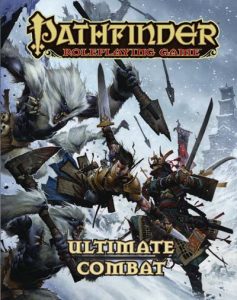
Somewhat the counter to Ultimate Magic as Combat focuses on all aspects of fighting with more archetypes, classes and whatever.
Chapter 1 is over a quarter of the book but it’s divided into two sections. New Classes and additional Archetypes for any existing class with a martial element. As for the new classes, only one is original (Gunslinger) and the other two are Japanese takes on the existing: Ninja for Rogue and Samurai for Cavalier. Gunslinger has numerous cool abilities yet Pathfinder‘s take on most firearms doesn’t progress past the (American) Revolutionary War. They’re expensive to buy, ammunition is expensive, they break easily and to add insult to the costs, they don’t inflict much damage (1d4 to 1d8) unless you nail the target with a successful critical hit, then the damage is quadrupled. Being part of a Fantasy game gives Gunslingers access to magical ammo and I’m confident their weapons can be enchanted like bows.
Ninjas follow much of the same breakdown as the Core Rogue with ki thrown in to power their tricks. Samurai are no different than Cavaliers beyond the gear.
The archetypes are focused on combat possibilities but not exclusively. There’s archaeologist for Bards, merciful healer for Clerics and charlatan for Rogues.
Chapter 2 contains combat feats with new categories in addition to the usual kind: Teamwork, Critical, Style and Performance. My personal favorite are the Style Feats for Monks. During my couple years in Houston, one of the independent TV stations would show those Hong Kong Kung Fu movies with martial artists using Tiger or Crane Style to take down their enemies. The Style Feats work in the same progressive manner as Power Attack leads to Cleave leads to Greater Cleave. Can a Monk know multiple styles? I think so, the trick is to have the ranks in certain skills. Feats, Levels and Stats are a given.
Chapter 3 covers “Mastering Combat” but half is dedicated to Oriental, gladiator and stone-age equipment with more detail on firearms and ammo for the Gunslinger. Then the rest is how handle duels, performance combat (gladiatorial battles namely) and siege engines should you want to remake those awesome Lord of the Rings scenes. I’m thinking of Helm’s Deep.
Chapter 4 is vehicles. This includes airships alongside the expected land and water-based stuff the PCs may encounter, rent or use.
Chapter 5 introduces some variant rules. Three out of four would slow the game down even further in my opinion: armor as damage reduction, piece-meal armor and Wounds and Vigor instead of hit points, the latter stinks of 4E. The called shots suggestion is nice and somewhat better than the generic -4 modifier when a player wants to take out an enemy’s eye or neck.
Chapter 6 is 42 pages of new, primarily combat-focused spells.
I failed to make the final case on Magic but I will here on Combat. Is this worth having? I have to give it a resounding yes and given a choice between Combat and Magic, I would go with Combat. Having some assistance on vehicles is a universal matter because traveling great distances to faraway lands is a core element to the game. Plus I’m a sucker for the Style Feats to make Monks different.
There will be a pocket version coming this Summer.
